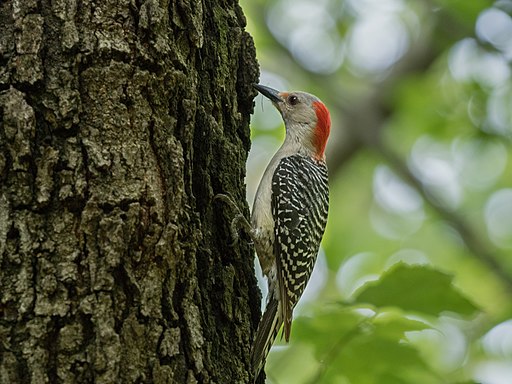Observing Woodpeckers in Florida: Types Variety and Circulation
Observing Woodpeckers in Florida: Types Variety and Circulation
Blog Article
Discover the Remarkable World of Woodpeckers: Whatever You Need to Know
The globe of woodpeckers is a world loaded with unique actions, elaborate adjustments, and a diverse array of varieties. From their habitats and circulation patterns to their feeding routines and specialized anatomical attributes, woodpeckers have long astounded the rate of interest of ornithologists and nature enthusiasts alike. Recognizing the complexities of these fascinating birds gives a look into the intricate interplay in between their biology and the environment. As we explore the globe of woodpeckers further, we reveal a wealth of info that sheds light on their value in ecosystems and the obstacles they deal with in an ever-changing globe.
Woodpecker Habitats and Distribution
In North America, for instance, woodpeckers can be detected in both coniferous and deciduous woodlands, utilizing their solid beaks to forage for bugs and produce nesting cavities in trees. In Africa, particular woodpecker types have adjusted to arid environments, such as the acacia timberlands, where they play a critical function in controlling insect populaces.

Feeding Behaviors and Diet Plan
Amongst the different elements of their habits, woodpeckers display distinctive feeding behaviors and nutritional choices. These birds are largely insectivores, with a diet regimen that consists of ants, beetles, caterpillars, and various other insects discovered in trees. Woodpeckers use their strong beaks to drill right into the bark of trees, penetrating for pests and larvae concealed beneath the surface. In addition to pests, woodpeckers additionally eat nuts, seeds, fruits, and sap. Some varieties have actually specialized tongues with barbed ideas that aid them remove pests from gaps in wood.
Woodpeckers are understood for their drumming habits, which serves not just to connect with other woodpeckers but additionally to find food. The rapid drumming audio is developed by the bird pecking on powerful surfaces like dead trees or steel posts. This behavior can bring in bugs hidden in the timber, enabling the woodpecker to discover their presence and prey on them.
Special Adaptations for Tree Climbing
In their adept pursuit of pests hidden within tree bark, woodpeckers have actually progressed amazing anatomical features that outfit them with special adaptations for effective tree climbing. One of the vital adaptations is their zygodactyl feet, with 2 toes directing ahead and two pointing backwards, providing a solid grip on tree trunks. This specific foot arrangement allows woodpeckers to stick to vertical surface areas effortlessly, enabling them to relocate up and down trees with agility. In addition, woodpeckers have stiff tail plumes that act as a helpful prop while they climb, assisting in balance and security. Their solid, chisel-like beaks are not only made use of for drilling right into timber however additionally for gripping onto bark as they rise tree trunks. Woodpeckers have strong neck muscle mass and an one-of-a-kind skull structure that take in the influence of consistent pecking, enabling them to climb up up and down without creating harm to their brains. These adaptations display the unbelievable transformative style that allows woodpeckers to browse trees with accuracy and performance.
Diverse Woodpecker Variety Worldwide
With over 200 various varieties spread out across various habitats worldwide, the family of Picidae includes an amazing diversity of woodpeckers. These birds can be found in woodlands, forests, savannas, and even urban areas, showcasing their adaptability to various settings. From the famous Northern Flicker in North America to the colorful and evasive Crimson-backed Flameback in Asia, each woodpecker varieties displays special attributes in terms of plumage, actions, and environment preference.
Woodpeckers differ substantially in dimension, with the small Downy Woodpecker measuring around 6-7 inches in size, while the effective Lineated Woodpecker can reach up to 17 inches - Woodpeckers in Florida. Their beaks additionally can be found in different shapes and dimensions, showing their feeding practices. Some varieties focus on extracting pests from tree bark, like the Acorn Woodpecker, while others, such as site here the Black-cheeked Woodpecker, eat fruits and seeds

Preservation Efforts and Difficulties
Preservation efforts for woodpecker populaces are important in reducing the influence of environment loss and various other threats facing these diverse avian species. Woodpeckers deal with different difficulties to their survival, mostly as a result of logging, urbanization, environment adjustment, and intrusive types. To address these concerns, preservation efforts focus on protecting and restoring woodpecker environments, applying lasting forestry techniques, and elevating recognition concerning the relevance of these birds in environments.
One substantial obstacle in woodpecker preservation is the fragmentation of their habitats, leading to separated populaces that are a lot more prone to extinction - Woodpeckers in Florida. Conservationists function to develop wildlife corridors and protected locations that link these fragmented habitats, allowing woodpeckers to view website move in between various areas for feeding, breeding, and sanctuary
/https://tf-cmsv2-smithsonianmag-media.s3.amazonaws.com/filer_public/30/ac/30acf469-09cd-4fcc-a812-1aa30f477578/aprmay2024_l09_woodpeckers.jpg)
Final Thought
In conclusion, woodpeckers are fascinating birds with distinct adaptations for tree climbing and feeding habits. They can be located in varied environments worldwide, encountering conservation difficulties because of habitat loss and human activities. Comprehending their habitats, diet plans, and habits is vital for conservation efforts to safeguard these essential bird types. Further research and conservation actions are needed to ensure the survival of woodpeckers in the wild.
Report this page